Key Points:
- SpaceX's Starlink remains the dominant player globally when it comes to satellite internet - overwhelming legacy players with an unprecedented number of satellites in orbit.
- Amazon's Project Kuiper is the most credible future Starlink competitor - but Amazon has only barely started in this particular space race.
- Satellite communication directly to cell phones is becoming a reality - with Apple leading the way, but many others (including Starlink in partnership with T-Mobile) are racing to bring to life a vision of connectivity very nearly everywhere.
- There are a LOT of other new space-based internet options in the works, but only a few will ever trickle down to have an impact on most consumer mobile internet users.
A lot has changed since our last big-picture overview of the state of the satellite internet industry as it applies to mobile internet for consumer RVers and boaters, published way back in late 2022.
But in many ways - not a lot has changed at all.
Then, as now, the state of the satellite internet industry for RV & boat mobile internet users could be summed up as follows:
SpaceX is advancing Starlink at ludicrous speed, and everyone else looks to be standing still in comparison.
But with a little closer inspection - just above the Kármán line, things are actually more interesting than they might first appear.
Amazon actually has the first few Project Kuiper satellites in orbit, OneWeb has a fully functional phase one constellation, legacy giants Hughesnet and Viasat have significant new capabilities stumbling online, and there are more promising new satellite internet projects in the pipeline now than ever before.
Do any of them have the right stuff to catch up with Starlink?
And will satellite ever rise to the level of being a fully credible alternative to 5G cellular?
And what about the fantastical realm where satellites and cellular cross paths - will the entirely new generation of satellites capable of communicating directly with existing unmodified cell phones actually prove worthwhile?
We've got the latest news on the new space race.
Read on for updates from all the players...
Table of Contents
Mobile Satellite Industry Update Video
Starlink Dominates the Skies
SpaceX now has well over 5,000 operational Starlink satellites in orbit and has been launching more at an unprecedented pace - launching new batches of 20+ satellites at a time, sometimes multiple times per week.
That adds up to a LOT of satellites - and SpaceX has built a constellation that dwarfs everything else in orbit.
But even still, SpaceX has been struggling to meet the seemingly insatiable demands for data that have been dragging down performance in many areas - and the actual observed real-world Starlink performance in some places has been decreasing despite the increasing capacity in orbit.
Starlink Coverage Now Pretty Much Everywhere
With the bulk of its phase one constellation deployed - SpaceX can now offer truly global coverage - with only a lack of local ground infrastructure and licensing restrictions still holding things back in some countries.
As of February 2024, SpaceX can legally offer Starlink service in 70 countries - and thanks to the laser relay links between satellites, coverage is now possible worldwide in international waters and the most remote arctic areas.
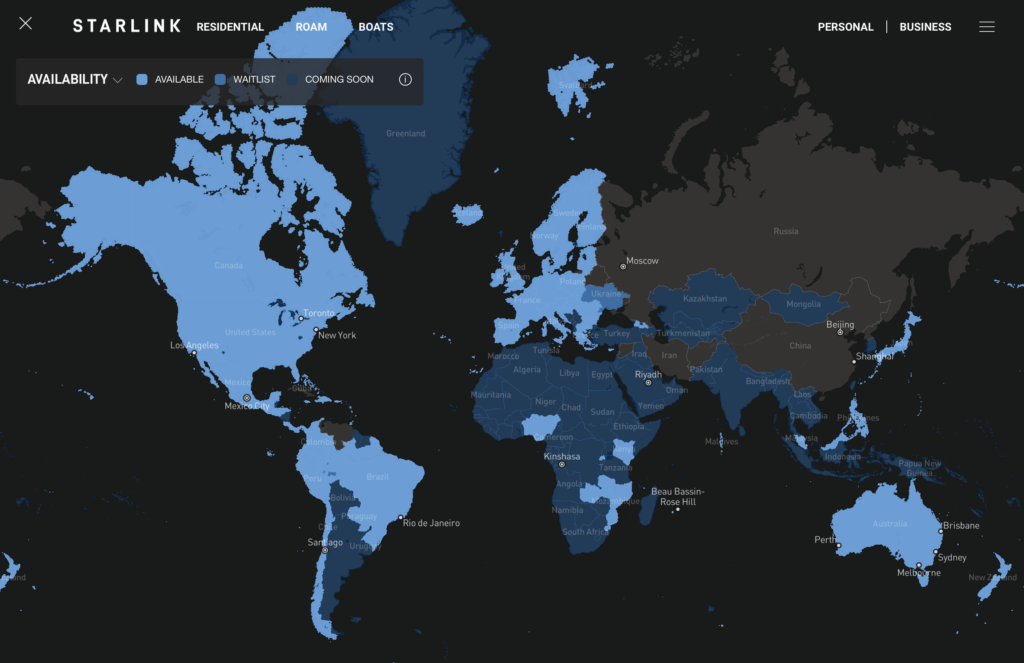
In the USA - the notorious waitlists for Starlink residential service are a thing of the past.
There are enough Starlink satellites online that anyone who wants to sign up can.
But Starlink still lacks the capacity to fully serve all the customers it has signed up. Real-world speeds are inconsistent and sometimes frustratingly slow - especially upload speeds. And Starlink has not (yet) fully delivered on the low latency potential of low earth orbit satellites, particularly when compared to 5G cellular.
Starlink “Mini” Dish Still Coming?
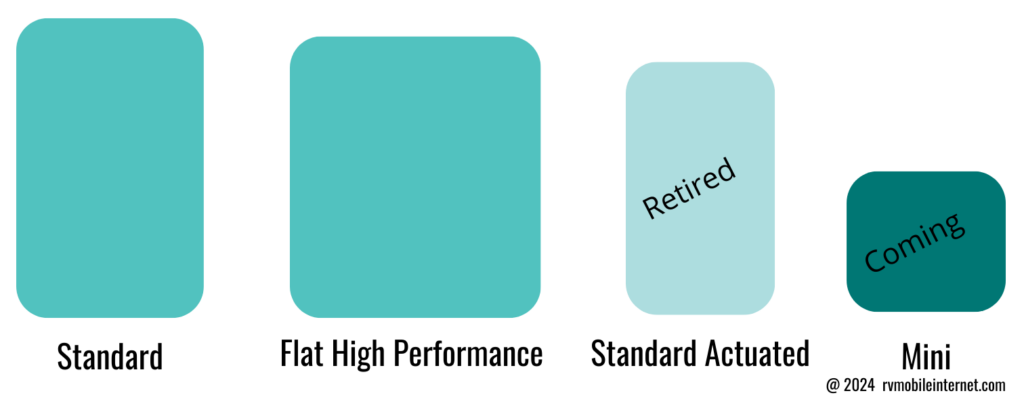
On the hardware front - SpaceX recently retired the "Standard Actuated" receiver and replaced it with a larger and more power-hungry new model.
In the pipeline - there is also a much smaller (and likely lower performance) "Starlink Mini" still in the works, recently confirmed by Elon Musk as coming to market later in 2024.
This is the Starlink hardware lineup we expect to see available by the end of 2024:
- Starlink Flat HP - Highest performance premium-priced system - officially supporting in-motion usage. $2,500
- Starlink Standard - The new "Gen3" consumer model for residential and portable installations. $599
- Starlink Mini - Physically small enough to carry in a backpack. It is likely much more power efficient and certain to sacrifice performance. Price and release date unknown.
Exactly when the Mini will come out and whether or not it will be a viable option for RVers and boaters remains anyone's guess.
To understand which Starlink hardware and plans we recommend (and why), check out our free and regularly updated guide focused on all things Starlink:
Starlink Satellite Internet for Mobile RV and Boat Use
Starlink’s Future is Still Riding On Starship
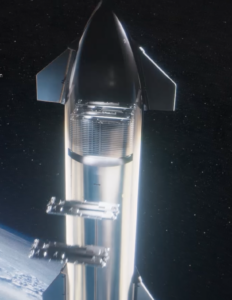
SpaceX is looking forward to the physically much larger and more capable Starlink V2 satellites to truly deliver the full vision for Starlink.
But the Starlink V2 satellites are too big to launch on SpaceX's workhorse Falcon 9 rocket, and will require SpaceX's massive Starship and Super Heavy booster to come online to be able to launch the V2 constellation economically.
SpaceX had expected Starship to be ready by now, but when the program began to slip, SpaceX modified its license requests with the FCC to develop a Plan B to keep the Starlink constellation growing.
Until Starship is ready to deploy the full-size V2 satellites - SpaceX is deploying a scaled-back "V2 Mini" satellite design that delivers some of the full-size capability of the V2 in a smaller package that fits on a Falcon.
The V2 Mini is claimed to have 3x to 4x the data processing capacity of the original Starlink satellites, but the extra size and weight limits the Falcon to launching just 23 at a time - as opposed to the 60 that SpaceX was able to deploy per launch of the initial Starlink satellite design.
To really kick the V2 constellation into gear - SpaceX needs Starship.
The best forecast is that Starship might be ready to enable Starlink V2 deployments by the end of 2024 - assuming everything goes right.
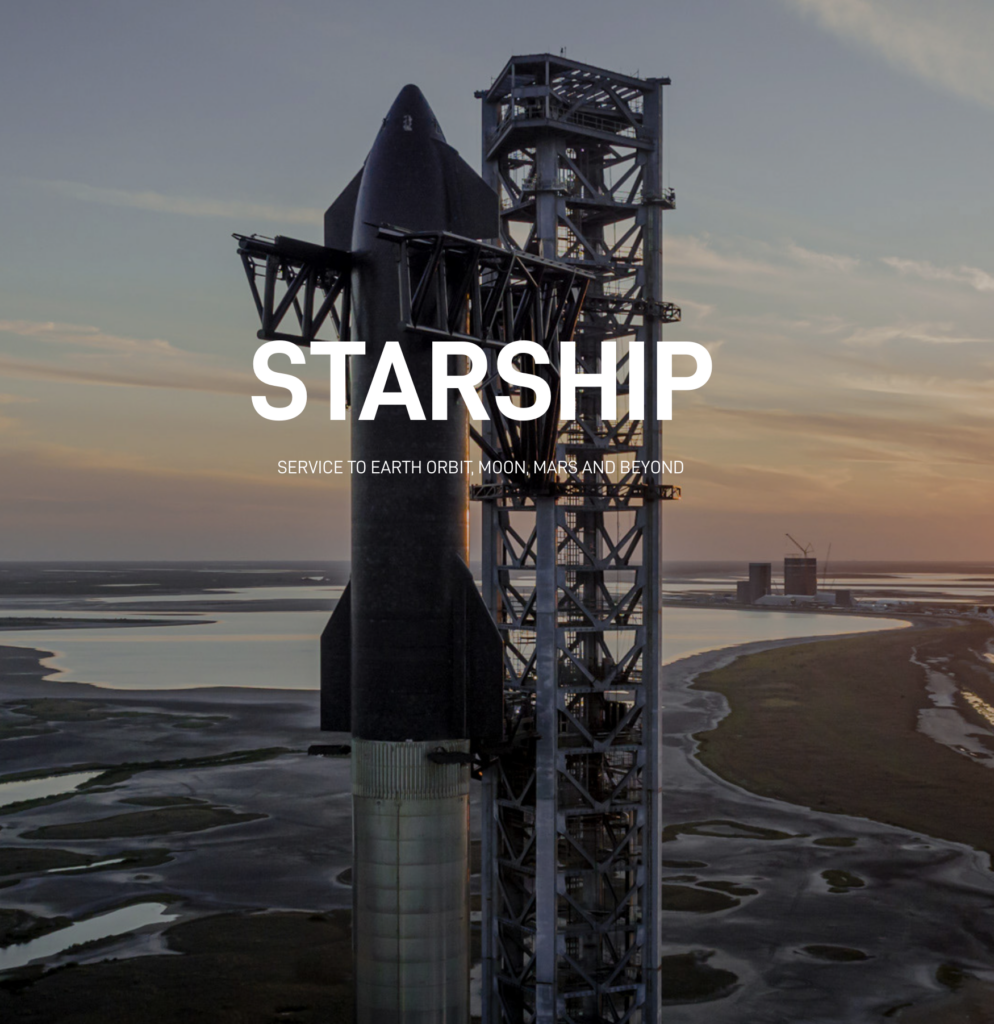
Starlink Direct To Cell Services Coming

SpaceX is looking to piggyback other types of service onto Starlink satellites - particularly the V2 satellites that will have more physical space and solar power available to put to use.
Most interesting - SpaceX and T-Mobile announced in late 2022 (our story and analysis) that they are working together to bring Direct-To-Cellular capabilities to Starlink Satellites. Beta testing is now underway.
But SpaceX and T-Mobile are not the only companies looking to enable satellites that can communicate directly with normal cellular devices.
For more on what SpaceX and all the others are up to - be sure to read that section later in this article.
Amazon’s Kuiper Prototypes At Last In Orbit!

With SpaceX having such a massive head start, it will take an incredible investment for any company to hope to catch up enough to launch a true Starlink alternative.
And one of the few companies with a credible shot to pull this off is Amazon - which has committed to investing the needed billions into its hugely ambitious Project Kuiper satellite constellation.
Over the past few years Amazon has teased details about its mysterious Project Kuiper constellation via infrequent online updates - but the pace has begun to pick up now that the first two Kuiper test satellites were launched in October 2023.
Amazon claims that these tests have allowed it to prove its architecture and demonstrate gigabit performance and inter-satellite laser links, clearing the way for Amazon to begin the massive undertaking required to rapidly launch its planned 3,236 satellite constellation.
To get this constellation into orbit as quickly as possible - Amazon has bought up almost ALL of the available launch capacity over the next few years from launch providers ULA, Arianespace, and Blue Origin.
And because the next-generation rockets from all three of these providers have slipped schedules - Amazon has even reached out to its nemesis SpaceX to book some Kuiper launches on SpaceX's Falcon.
Amazon is currently aiming to begin production launches for Kuiper in 2024, with limited beta testing for partners (including Verizon) beginning by the end of the year.
Here is Amazon's latest statement on Kuiper's aggressive timeline:
"Project Kuiper is a long-term initiative. Our FCC license requires that we deploy and operate at least half of our satellite constellation by July 2026. We launched our first two prototype satellites on October 6, 2023, and we expect to provide service to the earliest Project Kuiper customers by the end of 2024."
However, it will likely not be until sometime in 2025 (or beyond) that Kuiper is ready for actual consumer use.
Kuiper’s Tiny User Terminals

In early 2023, Amazon gave a sneak preview of the receivers designed to work with the Project Kuiper constellation.
The three terminals are interesting indeed - and pack a punch for their size:
- Small - An ultra-compact and "lower cost" design measuring 7" square and weighing just 1 pound. This design is capable of 100 Mbps.
- Medium - The standard Kuiper terminal is 11" square, 1" thick, and weighs 5 pounds. Amazon claims to be able to produce this terminal for "less than $400" and that this terminal will be capable of 400 Mbps speeds.
- Large - The professional / enterprise Kuiper receiver is 19" x 30", and is capable of up to 1 Gbps performance.
Additional details on Project Kuiper's hardware and service plans remain unknown.
Kuiper is definitely worth watching, but we don't expect it to be a relevant consideration for nomads anytime soon.
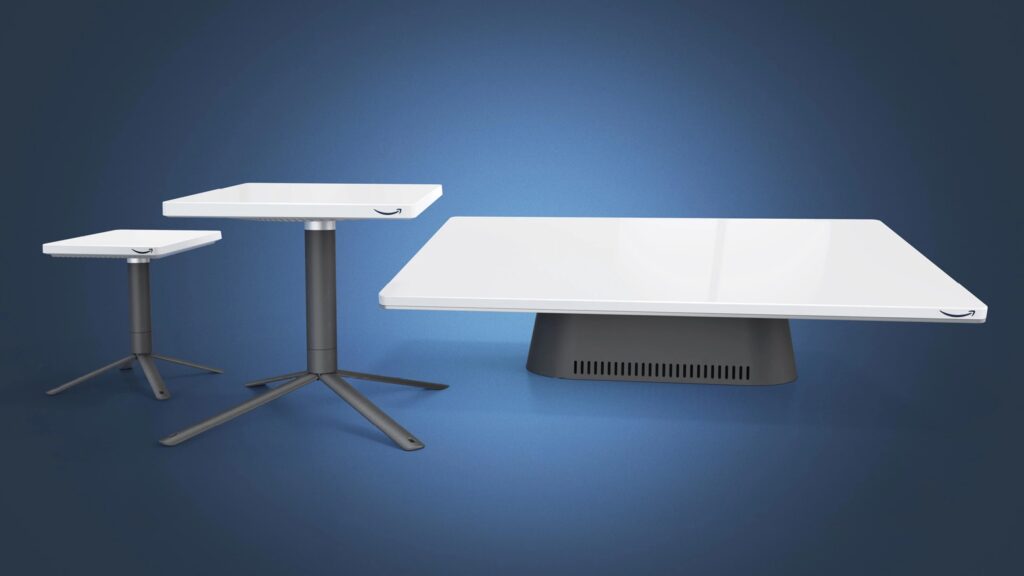
OneWeb Is Operational - And Mostly Irrelevant
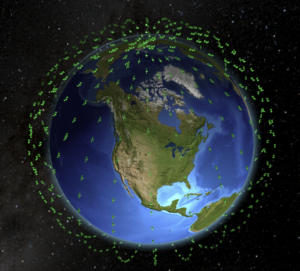
At one point, OneWeb actually looked likely to beat SpaceX in the race to be the first to launch a next-generation satellite constellation.
But OneWeb has had an incredibly rocky road getting its satellite broadband network off the ground.
Launching a new satellite constellation is VERY capital intensive - and since low earth orbit satellites are constantly in motion, you can't launch commercial internet service until you have enough satellites in orbit to ensure that at least one is passing over the areas you want to serve at any given time.
A partially built constellation is essentially useless.
And this was where OneWeb was stuck for years - dealing with delays caused by the pandemic, a bankruptcy, and then Russia's invasion of Ukraine.
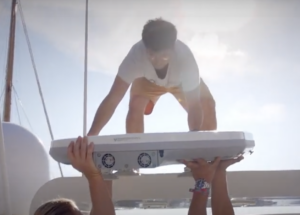
It wasn't until mid-2023 that OneWeb was finally back on track and fully ready for service - and by then, SpaceX had a dominant lead in the consumer market.
While OneWeb in the early days had plans to serve everyday consumers - now, rather than going against SpaceX with low-cost consumer-targeted service, OneWeb is primarily looking to provide satellite options to governments, cellular carriers (as tower backhaul), and other large enterprise customers.
OneWeb has merged with European satellite company Eutelsat, allowing Eutelsat and OneWeb to create solutions combining traditional geosynchronous (GEO) satellites with the low earth orbit (LEO) OneWeb constellation.
The closest thing to consumer service riding on OneWeb at the moment are services offered in partnership with Kymeta.
Kymeta's large flat Peregrine u8 for the marine market and Hawk u8 antenna for vehicles are claimed to be capable of 200 Mbps download and 20 Mbps upload, with sub 100ms latency.
This is comparable performance to Starlink - but service plans and pricing seem targeted towards the very limited Super Yacht crowd.
For our audience of consumer RVers and boaters - OneWeb has seemingly become irrelevant.
But in the future, the combined resources of Eutelsat and OneWeb might prove interesting again. OneWeb is working towards a second generation GEO/LEO hybrid constellation - but the earliest it will be ready for service seems to be 2028.
OneWeb is also partnered with Hughesnet (discussed below), and Hughesnet may eventually bring out a hybrid GEO/LEO service as well.
Can Legacy Satellite Ever Strike Back?
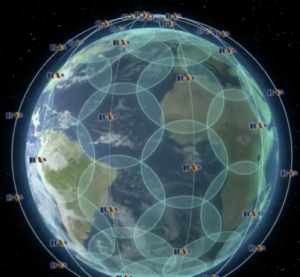
While OneWeb, Starlink, and Kuiper aim to circle the globe with hundreds or thousands of small low-earth-orbit (LEO) satellites - the traditional geostationary satellite industry still hasn't given up.
Just consider the math of it all.
The nature of LEO satellites is that they spread their capacity evenly across the entire planet underneath their orbits. But all of the planet's populated landmasses combined only represent a small portion of the Earth's surface - and the continental United States, in particular, is less than 2% of the surface.
This means that most LEO satellites like Starlink are essentially sitting idle at any given time - passing over oceans without any customers to serve, except perhaps some sporadic transoceanic cruisers.
On the other hand, geostationary satellites sit in a fixed location in the sky, 22,300 miles above the equator.
From there, these satellites can be designed to focus all their capacity onto a target area - making it theoretically easier and cheaper to target capacity to a particular country or area.
Things have been exceedingly dull in the geostationary satellite world for years - but that began to change in 2023.
Unfortunately, the news has not been all good.
ViaSat-3: Geostationary Giant Stumbles
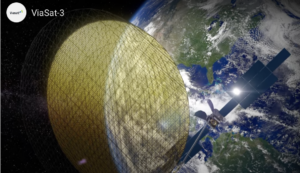
Legacy satellite broadband leader ViaSat (formerly known to many as Exede) was aiming to deploy a new geostationary constellation consisting of three absolutely gigantic satellites to deliver next-generation performance around the world using a more traditional geosynchronous satellite architecture.
Each of the ViaSat-3 satellites weighs 6.4 tons (20x the mass of a 650lb Starlink satellite) and is capable of terabit speed processing - making these ViaSats the largest and most advanced civilian communications satellites ever built.
When ViaSat-3 was originally proposed, each of the individual planned ViaSat-3 satellites was designed to have more raw data capacity than ALL other commercial satellites currently in orbit - combined!
After years of delays, the first ViaSat-3 was launched in April 2023.
And then tragedy struck when the satellite's gigantic antenna failed to properly unfold once it reached its target orbit.
ViaSat spent the past year regrouping from this failure - working to ensure the next two ViaSat-3 launches do not suffer the same fate. These two satellites are now on track for launch in late 2024 and mid-2025. The next ViaSat-3 satellite will replace the failed one over North America - and unless a new third satellite is built, true global coverage will be limited.
We have tracked ViaSat-3 since it was first announced in 2015, with a first planned launch in 2019 - and at the time ViaSat told us they had intentions to eventually serve the RV and mobile market. If ViaSat-3 had launched (successfully!) on time, it would have been revolutionary.
Now - ViaSat increasingly seems like a stumbling dinosaur.
In the meantime - ViaSat has purchased and merged with British satellite communications company Inmarsat.
Inmarsat was a leader in legacy low-speed satellite voice and data - and is pursuing long term plans to enable a new generation of satellite-to-cellular connectivity with its own hybrid LEO/GEO architecture.
It will take years for these new options to come to market - leaving ViaSat mostly on the sidelines for now, waiting and hoping that the next ViaSat-3 launch can turn things around.
Hughesnet: Jupiter Rising

Legacy satellite pioneer Hughesnet was pretty much the only game in town for consumers in remote locations looking to keep connected a decade or more ago.
But as cellular, Starlink, and other broadband options have reached into more of these isolated areas - customers have been fleeing Hughesnet in droves.
The old Jupiter 1 (2012) and Jupiter 2 (2016) satellites just didn't have the raw capacity to compete in a world of streaming video and high data needs.
Hughes is hoping that the new much more capable Jupiter 3 ("the world's largest and most advanced commercial communications satellite" since ViaSat-3 couldn't claim the crown) will change the equation - at last allowing Hughesnet to offer "unlimited" data plans with promised speeds up to 100 Mbps.
And to help mitigate the unavoidable 500ms latency hit from the speed of light delay that comes from bouncing signals off a satellite 22,236+ miles away - the formerly experimental Hughesnet Fusion option is now widely available, combining the raw speed of satellite with the lower latency of cellular.
Basically - behind the scenes, the Hughesnet modem is capable of combining satellite and cellular to help mitigate some of the latency issues that geostationary satellites have.
With aggressive pricing (compared to Starlink) Hughesnet is once again proving more competitive for fixed location rural installations.
But Hughesnet requires a two year contract, professional installation, and a precisely aimed traditional dish. And for Fusion service you need to be in an area with cellular signal on a Hughesnet partner to provide the low-latency uplink connection.
In other words - Hughesnet Jupiter 3 service is NOT currently mobile friendly for RVers and boaters.
Until Hughesnet (or a resale partner) embraces mobile customers with Jupiter 3 service - the latest advances from Hughesnet will remain of little interest to most of us who are nomadic.
Looking further into the future - Hughes is an investor in and partner with OneWeb, and there is a long-term plans to bundle OneWeb service and HughesNet service together in ways that combine the low latency of LEO with the raw focused capacity of GEO.
HughesNet president Pradman Kaul explained that cellular, LEO, and GEO will all be brought together:
“We are rapidly entering an era in which hybrid connectivity—both multi-transport and multi-orbit—will be commonplace."
This still likely remains years away - but it might prove to be very interesting once this hybrid technology matures and hopefully becomes available for mobile users.
Satellite Direct to Cellular
Over the past few years there has been the explosion of interest in using satellites to communicate directly with cellular devices, without any external hardware required.
Communicating from satellites hundreds of miles overhead directly to the tiny radios found inside cellular devices almost sounds like science fiction - but several companies are moving to make this dream a reality.
But service from the stars is NOT going to be bringing broadband to your pocket anytime soon. Basic text messaging and emergency communications seem to be what is in store in the near term future.
Here is the latest from the players attempting to make space-based communication a reality.
Apple & Globalstar: Emergency SOS via Satellite
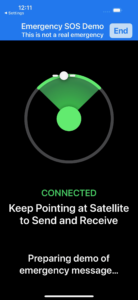
One of the key features Apple integrated into the iPhone 14 line (and onward) is support for emergency messaging via satellite, allowing messaging for help anywhere you can get a clear view of the sky - regardless of cellular coverage.
This service is built in partnership with Globalstar, the company behind the SPOT trackers, and it utilize Globalstar's already existing satellites and licensed spectrum rights.
By tapping into existing infrastructure, Apple was able to roll out this service back in November 2022, giving Apple a huge head start - but with a very limited offering.
Going forward - Globalstar committed to devoting 85% of its current and future satellite capacity towards Apple, and Apple is providing a huge influx of cash that will allow Globalstar to launch a significantly upgraded constellation of new satellites that should be fully online by 2026.
Globalstar has revealed plans to launch a new generation of 17 satellites beginning in 2025 that will vastly expand what the Globalstar satellite network is capable of. Apple is covering 95% of the projects costs, and will be guaranteed access to 85% of Globalstar's new capacity going forward.
With an investment like this in play - it is clear that Apple very likely has broader future satellite ambitions beyond just basic SOS services.
But Apple's notorious secrecy means that it is unlikely that we'll learn many more details about what is planned until new services are actually ready to be launched.
Starlink “Direct To Cell”
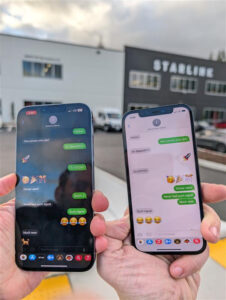
In January 2024, SpaceX launched the first six Starlink V2 Mini satellites with Direct to Cell capabilities for testing.
These Direct to Cell satellites are capable of communicating with most existing 4G phones - with no special additional hardware required.
While this new technology is indeed exciting, one of the most important limitations to understand is this is a secondary cellular payload piggybacking on top of normal Starlink satellites, and the cellular signal is extremely limited in bandwidth compared to the regular Starlink broadband service.
Direct to Cell service depends on borrowed cellular spectrum that is repurposed from earthbound use - so Starlink can only provide a signal in locations it has a terrestrial cellular partner who is willing to give up some of its airwaves.
In the USA - this partner is T-Mobile.
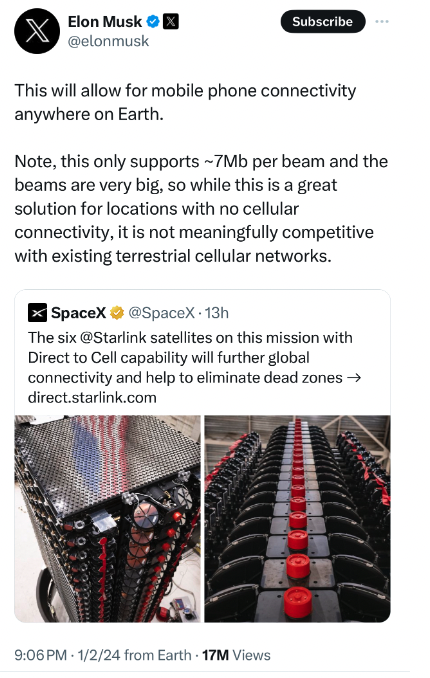
Direct to Cell is NOT meant to be Starlink broadband service for cell phones!
In fact, when this technology first comes online - it's only going to support basic text messaging services.
Elon Musk has posted on X trying to manage expectations about what Direct to Cell will be capable of:
"Note, this only supports ~7Mbps per beam and the beams are very big, so while this is a great solution for locations with no cellular connectivity, it is not meaningfully competitive with existing terrestrial cellular networks."
The primary early uses of Direct to Cell will be in enabling T-Mobile customers to text friends or family members from the middle of nowhere, or for allowing people to contact emergency services when they don't have cellular connectivity.
This is more of a competitor to satellite messengers, like Garmin InReach and Zoleo, than a replacement for normal cellular service.
But the great thing is that this messaging service will be available on the cell phone you are already own - without needing a separate device.
SpaceX currently has an FCC license to conduct limited testing to prove that its Direct to Cell service can work without causing interference.
SpaceX's FCC testing license allows for testing to run through June 2024, and is limited to 840 Direct to Cell equipped satellites communicating with just 2,000 test devices located in 25 pre-designated ground locations.
Starlink's Direct to Cell website forecasts that consumer texting service via partner T-Mobile in the USA will start sometime in 2024 (likely in a beta fashion), followed by voice & low-speed data in 2025 and beyond once more Direct to Cell satellites are launched.
If SpaceX is able to meet this ambitious rollout schedule - outdoor cellular dead zones really will soon become a thing of the past.
What About The Tesla Phone?

Despite SpaceX actively partnering with cellular carriers around the world - some people still seem convinced that Tesla or SpaceX is working on a phone of its own that will incorporate true Starlink broadband connectivity and not just traditional cellular from space.
We've analyzed the source of these rumors and debunked the Tesla Model P (Pi) smartphone in a past article, but we still regularly run across people who are certain this is a real imminent product that will make cellular carriers obsolete.
This is not a real project!
SpaceX has been clear from the start that Starlink, and particularly the Direct to Cell payload, is meant to complement cellular carriers - not to compete with or replace them.
Wishing otherwise is just buying into some completely unfounded hype.
Cellular Broadband From Space: AST SpaceMobile
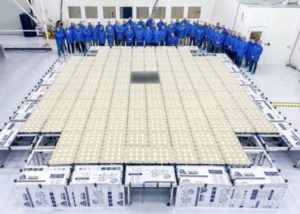
Though SpaceX tends to hog the headlines - it isn't the only company that has demonstrated satellite communications with unmodified cellular devices.
After several years of smaller scale tests, AST SpaceMobile began testing its full-scale prototype BlueWalker 3 satellite in orbit in late 2023, in partnership with AT&T.
Because the BlueWalker's antennas are so enormously large, SpaceMobile claims they will be sensitive enough to communicate with phones even when they are indoors!
Antennas this large may actually be able to reach broadband speeds beyond just basic messaging.
With the test satellite, SpaceMobile is claiming to have already demonstrated satellite voice calling, and 5G data connections with 14 Mbps speeds - successfully streaming video via satellite to a smartphone.
The full production SpaceMobile satellite should be even more capable - but of course that speed and capacity will end up divided up amongst all the connected devices within range.
SpaceMobile has a spectrum license and partnership agreement with AT&T in the USA, and AT&T has talked about using SpaceMobile to eliminate dead zones in a way that sounds very similar to what T-Mobile and SpaceX announced.
Now that SpaceMobile has completed a successful demo mission - it has signed on AT&T and Google as investors to fund deploying the 243 satellite constellation necessary for continuous coverage. The first five production SpaceMobile satellites are slated to launch in the first half of 2024 - with things ramping up quickly from there.
SpaceMobile has a lot to prove in the years ahead - but if its technology pans out, it might prove to be truly revolutionary.
Satellite Messaging Everywhere: Lynk
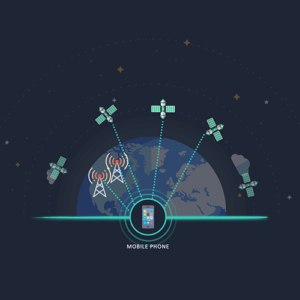
Satellite startup Lynk in 2020 was the first company to demonstrate sending a text message from a satellite to a normal cellphone, and Lynk has ambitious plans to build a 5,000 satellite constellation that enables messaging, voice calls, and more in partnership with terrestrial carriers.
Until enough of the Lynk constellation is built out to provide 24/7 coverage - Lynk will support non-realtime messaging.
Lynk messages may take up to 30 minutes to go through since the Lynk satellites will not be set up to provide 24/7 coverage at first.
Lynk does not have spectrum rights of its own, so it can only operate in locations where it has a partnership with a local cellular carrier that is willing to share spectrum with Lynk in return for a cut of the roaming fees.
Lynk has signed up carrier partners in many countries around the world, including Rogers in Canada. But it has not announced a partnership with a major US carrier yet.
Lynk currently has three satellites in service - and commercial Lynk service has so far only been made available in a few small island nations, such as the Solomon Islands.
Lynk will need to expand rapidly to demonstrate that it has a viable path forward to justify the investment that will be needed to build out the full Lynk constellation.
Other Satellite Constellations In The Works

Even though not all of them will be successful or even make it to market - all of the satellite systems mentioned so far in this article are real and potentially viable projects with real hardware already in space.
We are also tracking a number of ambitious satellite projects and constellations that are more pie in the sky, often offering little more than prototypes or slide decks to lure investors.
Though the pace of SpaceX seems to indicate otherwise - the satellite industry more traditionally plods along at a glacial pace, with partnerships and launch plans taking years to finalize before a new product vision can even begin to be ready to be shown off to the public.
Here are some potential future satellite projects we have on our radar:
- Iridium Project Stardust - Iridium's 66 satellite constellation was the first to provide truly global coverage - and Iridium enables a wide range of satellite communicators and other low-bandwidth mobile devices. To try and remain relevant into the future - Iridium in early 2024 announced Project Stardust to repurpose the existing Iridium satellites to enable future integration with 5G-based satellite messaging and internet-of-things applications. The catch with Project Stardust is that it will not work with existing phones, and it requires new hardware on the receiving devices. Iridium hopes to begin testing Stardust in 2025, with service coming in 2026 - assuming device manufacturers play along and integrate compatibility.
- Telesat Lighstpeed - Lightspeed is a perpetually delayed 298 satellite constellation that will feature laser links between satellites. This constellation is not currently consumer focused, and the most recent first launch estimate is now targeting no sooner than 2026.
- E-Space - E-Space (in partnership with the government of Rwanda) raised eyebrows in 2022 by filing to secure a license to operate a future constellation consisting of 327,320 (!!!) tiny satellites. Everything about E-Space sounds absolutely over the top - but it is fronted by well-respected space industry veteran Greg Wyler, who was the original founder of OneWeb. E-Space has actually launched three test satellites, and more recently E-Space even completed a technology demonstration with US Space Force.
- Ligado SkyTerra - The geostationary SkyTerra 1 satellite launched in 2011 with the “largest reflector (22-meters) in service on a commercial satellite” and it was designed to theoretically enable low-bandwidth communication directly to small devices like phones. But Ligado has been struggling to get device manufacturers to build in support for its signal, and the Department of Defense has been blocking Ligado's plans to supplement the satellite with ground-based signals for extra capacity because of concerns that there might be GPS interference. If Ligado can solve its regulatory and legal woes - it might have something interesting to offer. But it has been slow going.
- Rivada Space Networks - Rivada claims to be building a 600 satellite constellation with laser interlinks, with deployment slated to start in 2025. Rivada bought up the old spectrum rights held by defunct satellite company Trion Space, and because of this Rivada claims that its satellites will have spectrum priority over both Amazon and SpaceX whenever their orbits conflict - potentially giving Rivada a competitive advantage. Rivada's stated goal is to provide wholesale satellite capacity to other companies. It will be interesting to see if anything worthwhile comes of this corporate maneuvering to claim priority spectrum.
- European "Starlink Competitor" - The European Union announced in 2023 that it was funding a consortium of European satellite companies to work together to build a sovereign European-controlled Starlink competitor, with an ambitious (and likely unrealistic) goal of being ready for service in 2027. Though details remain sparse, if and when this constellation comes online it may prove to be primarily focused on military and government traffic - and not on the consumer market.
- G60 "Starlink" - Chinese company Shanghai Spacecom Satellite Technology has raised nearly a billion dollars towards a planned 12,000 satellite mega-constellation. They even have the audacity to copy the Starlink name. Few other details have been released - but this is the second proposed mega-constellation that seems to be in the works in China.
Some of these projects will likely never get off the ground - and of those that do, we expect that few will have the ambition or scale to go after a broad mobile consumer market.
But one thing is certain - the skies will be getting crowded, and connectivity everywhere will be increasingly capable over time.
Concluding Thoughts
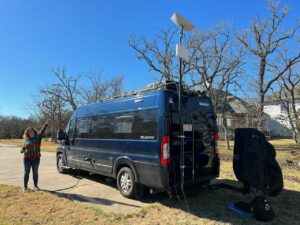
Many people watching from the sidelines think there is competition between satellite and cellular-based connectivity options - and that ultimately just one will come out on top as the ultimate way for RVers, boaters and nomads to keep connected.
That idea couldn't be more wrong - satellite and cellular are complementary technologies.
And as we have seen this year - they are growing closer and closer together.
Cellular devices will gain satellite capability, and remote cellular towers will tap into satellite backhaul.
Cellular, especially 5G upgraded towers with direct fiber connections to the internet, will always have a huge performance advantage over even the most advanced satellites in areas with a strong signal.
And in congested areas, building more cellular capacity will always be easier and cheaper than launching more satellites.
In many areas, cellular will always deliver faster downloads - and especially much faster uploads - than even the best satellite systems can offer. And, of course, cellular will work indoors and in the shade, places that satellites will always struggle.
But on the other hand - it will never be practical for cellular to achieve 100% coverage, and even as 5G continues to expand, fringe areas will always be relatively slow and frustratingly unreliable.
This is why it is no surprise then to see satellite and cellular companies partnering up:
- T-Mobile & SpaceX's Starlink
- Verizon & Amazon's Project Kuiper
- AT&T & AST Space Mobile
- Apple & GlobalStar
This is what the future looks like - connectivity everywhere, but behind the scenes more complicated than ever before.
For those who seek to keep connected - it makes sense to embrace all your options.
Further Reading
- Starlink Satellite Internet For Mobile RV And Boat Use - Our new featured guide focused on taking advantage of SpaceX's Starlink on the go.
- Mobile Satellite Internet Options -
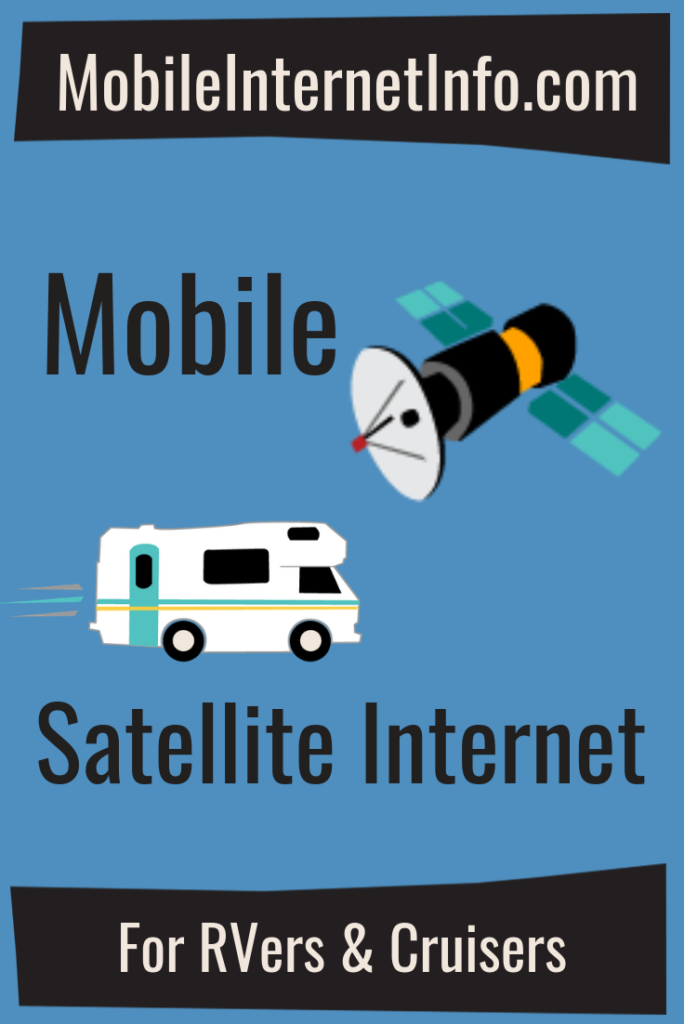 Our featured guide on all the current and future satellite internet options of interest to RVers and cruisers.
Our featured guide on all the current and future satellite internet options of interest to RVers and cruisers. - All our Satellite Internet Resources - Our collection of guides, gear center entries, and news coverage on satellite internet.
And here is all of our recent satellite internet coverage:
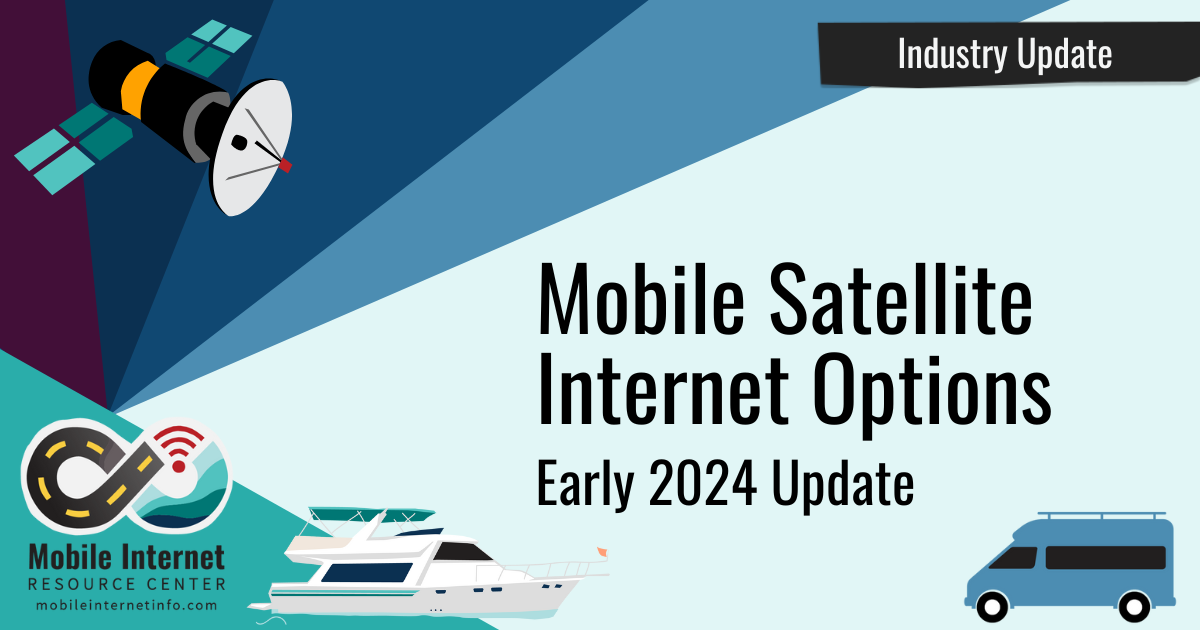







 Mobile Internet Resource Center (dba Two Steps Beyond LLC) is founded by Chris & Cherie of
Mobile Internet Resource Center (dba Two Steps Beyond LLC) is founded by Chris & Cherie of